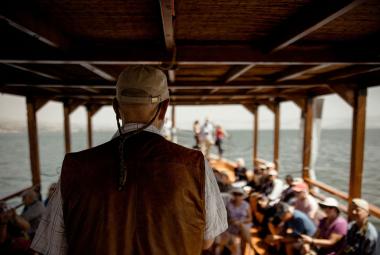[Personal note: I recently had an unusual experience while in my library that I cannot resist sharing with you. From time to time this happens and these incidents constitute some of the most exciting and satisfying experiences in my lifetime of adventures! I hope you find this as interesting as I have. -Chuck]
Many of us who have visited Israel regard the visit to the "Garden Tomb" as one of the major highlights of the trip. It invariably ranks highest on our feedback surveys. The people in charge of the British trust that manages the site always present it as simply "representative," rather than insisting that it is the actual tomb. However, we feel they are understating the actual facts. Even though I harbor a skeptical cynicism toward most "traditional" sites, for a number of reasons I personally regard this tomb as the actual one referred to in the Gospel accounts.
Notes From Leviticus
In my study I was digging through my library on the Book of Leviticus and, in particular, was digesting the commentary by Andrew Bonar (a classic that I particularly treasure regarding this particular book of the Torah). I was reviewing the many detailed specifications of the various categories of offerings - every one of which profiles or foreshadows the various aspects of Christ's person and work. I was particularly intrigued with the following:
And he shall kill it on the side of the altar northward before the LORD: and the priests, Aaron's sons, shall sprinkle his blood round about upon the altar
Leviticus 1:11
Like so many of the textual details, this one was also expressly fulfilled by the fact that the ultimate sacrifice to which it points was, indeed, offered on the north side of the city, just outside of what is now called the "Damascus Gate." However, a footnote also caught my eye that included some unusual details about Joseph of Arimathea, which proved strikingly instructive.
Joseph of Arimathea
Andrew Bonar's footnote noted: "A rich man, one of the most honorable and esteemed in Jerusalem, a member of the Sanhedrin, and a disciple, unexpectedly appears at Calvary. This was Joseph of Arimathea, without exception the most singularly noble character introduced to us in the Gospels. This rich man had been driven into concealment by the plots formed against him by the Jews, on account of his defending Jesus in the Sanhedrin openly (Luke 23:51)." In the Gospel of John we find a subtle but significant mistranslation:
And after this Joseph of Arimathea, being a disciple of Jesus, but secretly for fear of the Jews...
John 19:38
"...being a disciple": "kekrummenoV de dia ton fobon twn ioudaiwn" not [the adverb] "secretly," for it is not kekrummenwV but [the adjective] "secreted," or forced to hide, by reason of their plots. This makes his appearance before Pilate even more unexpected.
An Unrecorded Conversation
I cannot resist including the unrecorded conversation that occurred between Joseph of Arimathea and Pontius Pilate, who was, of course, shocked by Joseph's request for the body in the passage above. Pilate responded: "Joseph, I don't understand. You're the richest man in the region; you have made this brand new tomb for your family; and, you're going to give it to this criminal?"
"Oi Veh! It's just for the weekend!" Joseph responded.
(I have this on good authority: from Chuck Smith of Calvary Chapel.)
Where was His Tomb?
Andrew Bonar points out that in Isaiah 53 we find some very significant prophetic details:
He made his grave with the wicked [plural], and with the rich [singular] in his death;
Isaiah 53:9
I had always assumed that the "transgressors" in Isaiah 53:9 simply pointed to the two thieves who were crucified with Him. It was Bonar's insight that this refers to the burial itself, which included both the wicked and the rich. Another of the Levitical specifications deals with the offering being "...without the camp unto a clean place ..." (Leviticus 4:12; 6:11). It was this detail that actually gave rise to the Andrew Bonar's footnote: 1
Now in the place where he was crucified there was a garden; and in the garden a new sepulchre, wherein was never man yet laid.
John 19:41
The very spot that criminals were put to death was where Joseph's new tomb was hewn out of a rock! The stony sides of the tomb - the new tomb - "the clean place," where Jesus was laid - were part of the malefactor's hill. His dead body is "with the rich man and with the wicked" in the hour of His death! His grave is the property of a rich man; and yet the rocks which form the partition between His tomb and that of the other Calvary malefactors, are themselves part of Golgotha."
Anyone who has visited the Garden Tomb recognizes the validity of Bonar's perceptions: the site of Golgotha is topologically identifiable as at the peak of the ridge system between the Kidron Valley and the Tyropean Valley; midway between the Mount of Olives and Mount Zion. It is also a very short walk to the tomb, and the tomb itself seems to fit a number detailed specifications from the Gospel texts:
1. It is proximate to Golgotha (Jn 19:41).
2. It was a new tomb hewn in the rock (Mt 27:60; Lk 23:53; Jn 19:41).
3. It was a garden area (Jn 20:41, 42). The enclosed cistern of 250,000 gallons implying a single, very wealthy, owner.
4. It was adjacent to a wine press.
5. It had a rolling stone door (Mt 27:60; 28:2; Mk 16:3; Lk 24:2).
6. The tomb itself was just to right of a wailing chamber (Mk 16:5).
7. And, it is empty! (Lk 24:6, 12; Jn 20).
8. Gordon's Calvary
The present site of the "Garden Tomb" is often called, derisively, "Gordon's Calvary." It remains controversial despite the evidences that favor it. General Charles George Gordon was a British general who distinguished himself with assignments in the Crimean War and other exploits in the Far East. He was commissioned a second lieutenant in 1852, and eventually found himself assigned in Palestine. One day from his hotel he noticed the features of a "Skull Hill" and became convinced, despite church traditions to the contrary, that this was the true location of the crucifixion. His discovery was based on the physical features of the area, derisively called "Gordon's Calvary" by those who still favor the traditional site.
(The "Church of the Holy Sepulchre" is on the traditional site at another location that was selected by Queen Helena in the fourth century and was protected until 1009 A.D., when it was destroyed by Khalif Hakem. The Greek Orthodox Church and the Russians erected the present Church of the Holy Sepulchre in 1810, where it stands today.)
General Gordon's discovery of what we now know as the "Garden Tomb" was in 1883. What struck me about Andrew Bonar's observations, from the text, was that his commentary was published in 1846, almost 40 years before the discovery of the present site that so vividly presents the drama that is the very cornerstone of the entire Christian faith!2 It is inspiring to realize that the clarity of the situation was perceived by Andrew Bonar strictly from the text itself, without the physical benefits which we can presently enjoy on our visits to Jerusalem!
What an encouragement to all of us to pay close attention to details and to take them seriously! "Not one jot or tittle," indeed!3
Notes:
- Andrew Bonar, Leviticus , Banner of Truth Trust, Edinburgh 1846, footnote, p.116-117.
- Paul presents the discussion of the resurrection in 1 Corinthians 15 as the most important issue in the entire Bible (Cf. vv.13ff).
- Matthew 5:17, 18.




